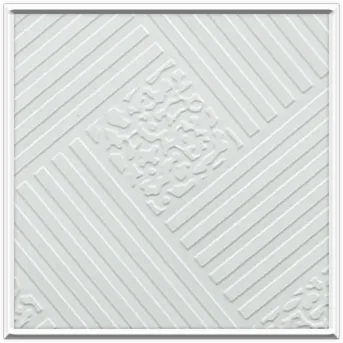Dec . 07, 2024 01:24 Back to list
Exploring the Intersection of Cross-Functional Teams and Organizational Ceiling Challenges
Understanding Cross T Ceiling A Design and Structural Perspective
The concept of a cross T ceiling is gaining popularity in contemporary architecture and interior design. This innovative ceiling type, which utilizes a grid of cross T-shaped members, offers unique advantages in terms of aesthetics, functionality, and cost-effectiveness. In this article, we will delve into the characteristics, benefits, and applications of cross T ceilings, showcasing why they have become a preferred choice for modern spaces.
What is a Cross T Ceiling?
A cross T ceiling is a type of suspended ceiling system formed by a grid, wherein the main runners are organized in a perpendicular arrangement, resembling the letter 'T' when viewed from below. This ceiling structure is typically comprised of lightweight materials such as mineral fiber, metal, or gypsum board, which are suspended from the building's structural ceiling. The cross T components provide support for various ceiling tiles or panels, creating a smooth and uniform appearance overhead.
Advantages of Cross T Ceilings
1. Versatile Design Aesthetics One of the standout features of cross T ceilings is their versatility. The grid pattern allows for a variety of ceiling tile designs, colors, and textures to be incorporated, enhancing the overall interior design. Whether aiming for a sleek, modern look or a more traditional aesthetic, cross T ceilings can accommodate a wide range of styles.
2. Easy Installation and Maintenance Unlike traditional plaster ceilings, cross T ceilings are relatively easy to install and can be completed quickly, minimizing labor costs. Additionally, the open grid design allows for convenient access to plumbing, electrical wiring, and HVAC systems, facilitating maintenance and repairs without the need for extensive demolition.
3. Sound Absorption and Acoustics Cross T ceilings can significantly improve the acoustics within a space. Many ceiling tiles used in conjunction with this system are designed to absorb sound, reducing noise levels and enhancing the auditory experience in environments such as offices, schools, and auditoriums. This characteristic is particularly valuable in settings where concentration and communication are vital.
4. Thermal Comfort A well-designed cross T ceiling can contribute to thermal comfort in a building. By accommodating insulation materials within the ceiling cavity, these systems can help regulate indoor temperatures, thereby promoting energy efficiency and reducing heating and cooling costs.
cross t ceiling

Applications of Cross T Ceilings
Cross T ceilings are widely used across a range of commercial, industrial, and residential settings. Common applications include
- Office Buildings The grid structure is frequently utilized in modern office environments to provide a clean, professional appearance while allowing for flexible workspace configurations and easy access to utilities.
- Retail Spaces Retail shops often employ cross T ceilings to create visually appealing environments that enhance customer experience. The ability to incorporate dynamic lighting fixtures within the grid can further amplify the overall ambiance.
- Educational Institutions Schools and universities benefit from the sound-absorbing properties of cross T ceilings, which contribute to a focused learning environment. Moreover, the ease of installation makes it practical for repurposing or renovating classrooms.
- Healthcare Facilities In hospitals and clinics, cleanliness and accessibility are paramount. Cross T ceilings support easy cleaning procedures and provide necessary access to infrastructure, making them a suitable choice for medical environments.
Conclusion
In summary, cross T ceilings represent a remarkable advancement in ceiling design and functionality. Their versatility, ease of installation, and benefits in acoustics and thermal comfort make them an attractive choice for a variety of applications. As modern architecture continues to evolve, the adoption of cross T ceilings is likely to increase, promising to enhance both the aesthetic and functional aspects of our built environment. Whether in a bustling office or a serene classroom, cross T ceilings are poised to elevate the spaces we inhabit, making them more adaptable and enjoyable for all.
-
Durable Ceiling T Grid Systems | Easy InstallationNewsAug.29,2025
-
PVC Gypsum Ceiling: Durable, Laminated Tiles for Modern SpacesNewsAug.28,2025
-
Pvc Gypsum Ceiling Is DurableNewsAug.21,2025
-
Mineral Fiber Board Is DurableNewsAug.21,2025
-
Ceiling Tile Clip Reusable DesignNewsAug.21,2025
-
Ceiling T Grid Modular DesignNewsAug.21,2025







